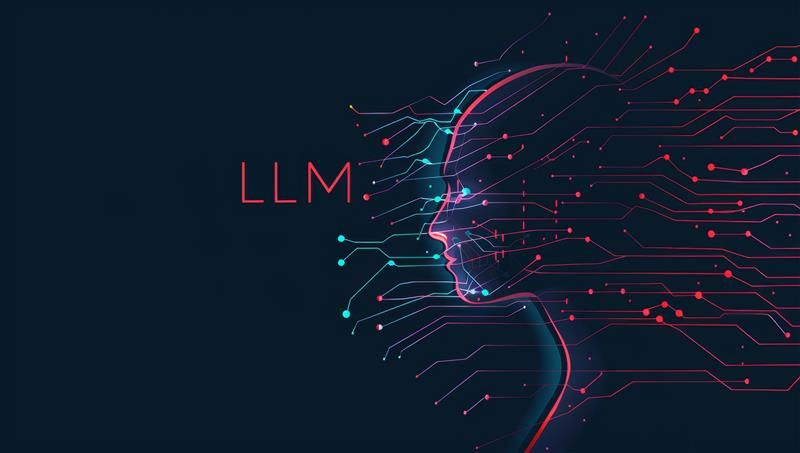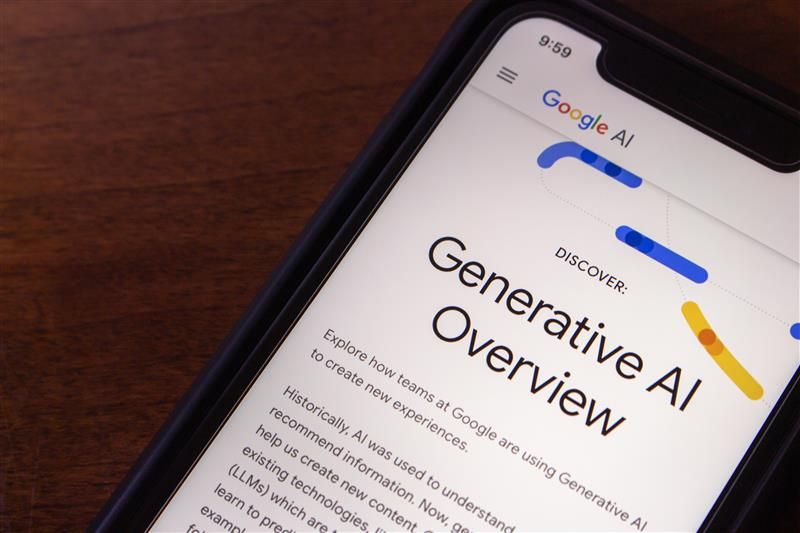In today's fast-paced digital landscape, generative AI tech stack is increasingly becoming a crucial part of innovative businesses. From automating content creation to enhancing decision-making, generative AI offers capabilities that can transform your software stack into a more powerful and intelligent system. However, integrating generative AI into your existing software infrastructure requires careful planning, understanding of the technology, and a strategic approach to ensure seamless operation.
In this comprehensive guide, we will explore how to integrate generative AI tech stack into your existing software system. We will dive into the necessary steps, best practices, and common challenges, offering actionable insights to help you succeed in your integration journey.
What is the Generative AI Tech Stack?
Generative AI is centered around creating models that autonomously generate content such as images, text, or code. This capability, known as generative modeling, relies on advanced algorithms to identify patterns and relationships within data, enabling the creation of new information. The generative AI tech stack encompasses the tools and technologies needed to develop and deploy these AI systems. Here are the key components:
Deep Learning Frameworks
At the heart of the generative AI tech stack are deep learning frameworks like TensorFlow and PyTorch. These frameworks are essential for constructing and training sophisticated AI models, enabling the manipulation of complex data. Within this realm, architectures such as Generative Adversarial Networks (GANs), Recurrent Neural Networks (RNNs), and Variational Autoencoders (VAEs) play a crucial role in generative AI, each contributing uniquely to the generation of new content.
Data Preprocessing Tools
Data preprocessing is a critical stage in generative AI, where raw data is cleaned, organized, and enhanced to ensure the generative models are trained effectively. Tools like Apache Spark and Apache Hadoop are instrumental in managing large and diverse datasets, ensuring that the data fed into AI models is of high quality and relevant to the desired outcomes.
Programming Languages
Programming languages form the backbone of generative AI development. Python is the most common language in this field due to its simplicity, extensive libraries, and strong community support. Python’s rich ecosystem includes libraries such as TensorFlow, Keras, and PyTorch, which are essential for developing and deploying generative AI models.
Deployment Tools and Platforms
Once a generative model is built and trained, deploying it in a production environment is the next critical step. Cloud-based platforms are typically used for this purpose because they offer scalability, flexibility, and seamless integration capabilities. These platforms ensure that generative AI applications can scale according to demand and are accessible to users.
Complex Generative AI Initiatives
Integrating a generative AI tech stack into complex initiatives often requires a combination of multiple frameworks and programming languages. As generative AI projects scale, the need for a more extensive and robust tech stack becomes apparent. This stack must support various aspects of AI development, from data processing to model deployment, ensuring that the AI systems perform efficiently and effectively.
Overview of generative AI tech stack layers
The generative AI tech stack is organized into distinct layers, each crucial for developing and deploying AI models:
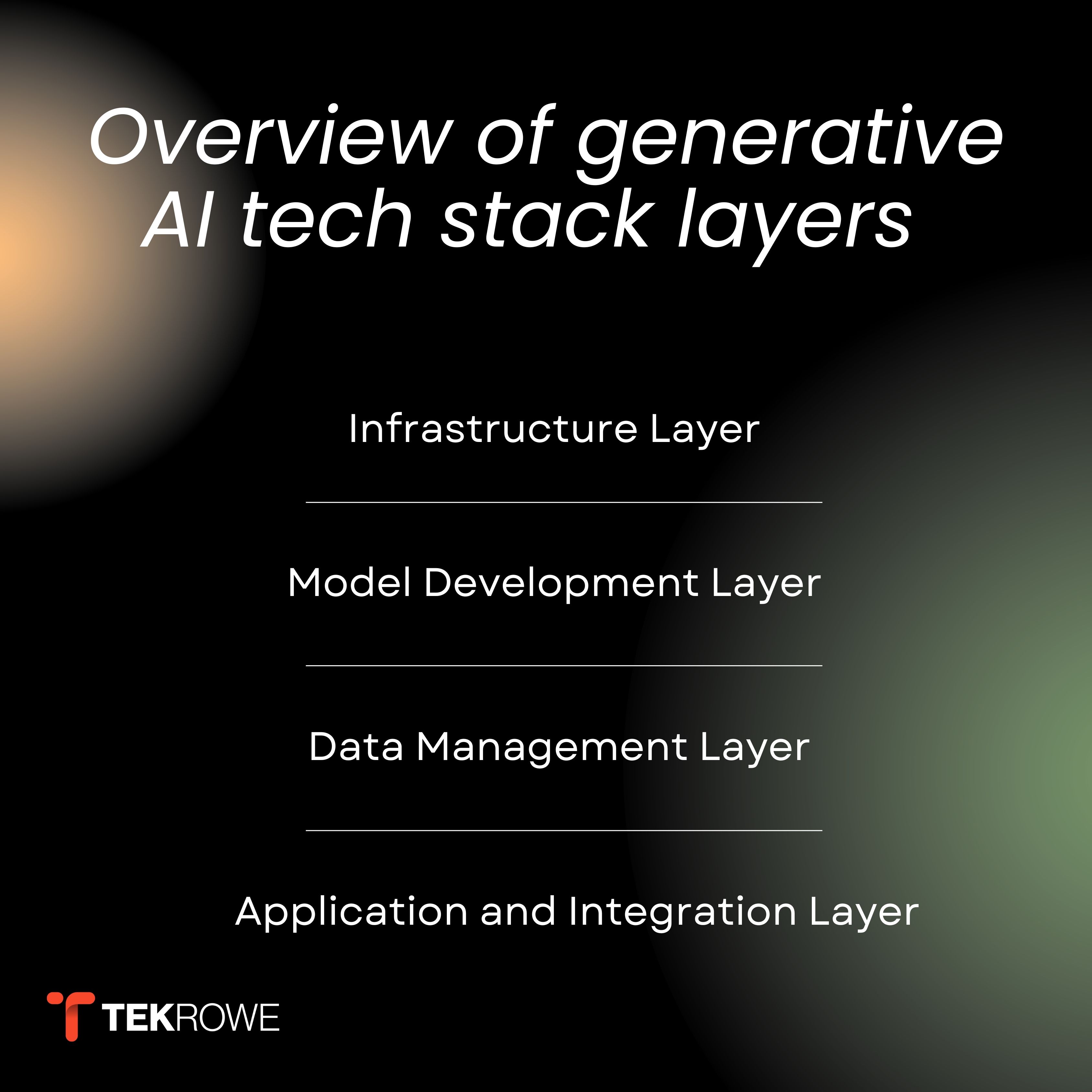
- Infrastructure Layer: This foundational layer provides the necessary computational resources, such as GPUs and cloud services, to support the intensive processing demands of AI models. It ensures that the gen AI tech stack operates efficiently, offering scalability and flexibility to handle varying workloads. By leveraging cloud platforms like AWS or Google Cloud, this layer also facilitates rapid deployment and real-time processing, which are essential for advanced AI applications.
- Model Development Layer: This layer is where the core of the generative AI tech stack is built. Using deep learning frameworks like TensorFlow and PyTorch, developers create and train models capable of generating new data. These frameworks offer the tools needed for implementing complex algorithms, including Generative Adversarial Networks (GANs) and Transformers, which are pivotal in generative AI. This layer is central to the machine learning technology stack, enabling the development of models that can learn from and mimic large datasets.
- Data Management Layer: Data is the lifeblood of any AI system, and this layer ensures that data is properly collected, cleaned, and prepared for use in model training. It involves tools like Apache Spark and Hadoop, which are integral to handling large datasets efficiently. This layer bridges the artificial intelligence technology stack with the machine learning tech stack, ensuring that data flows seamlessly from storage to the model training process, enabling high-quality, reliable AI outputs.
- Application and Integration Layer: The final layer focuses on deploying and integrating AI models into real-world applications. This involves using APIs, cloud-based platforms, and other integration tools to embed AI capabilities into existing software systems. This layer is critical for making the generative AI functionalities accessible to end-users, ensuring that the machine learning tech stack supports operational needs, including scalability, reliability, and real-time interaction.
Steps to Integrate Generative AI into Your Existing Software Stack
Integrating generative AI into your existing software stack can bring transformative improvements to your operations. Following a structured approach ensures successful implementation with minimal disruptions.
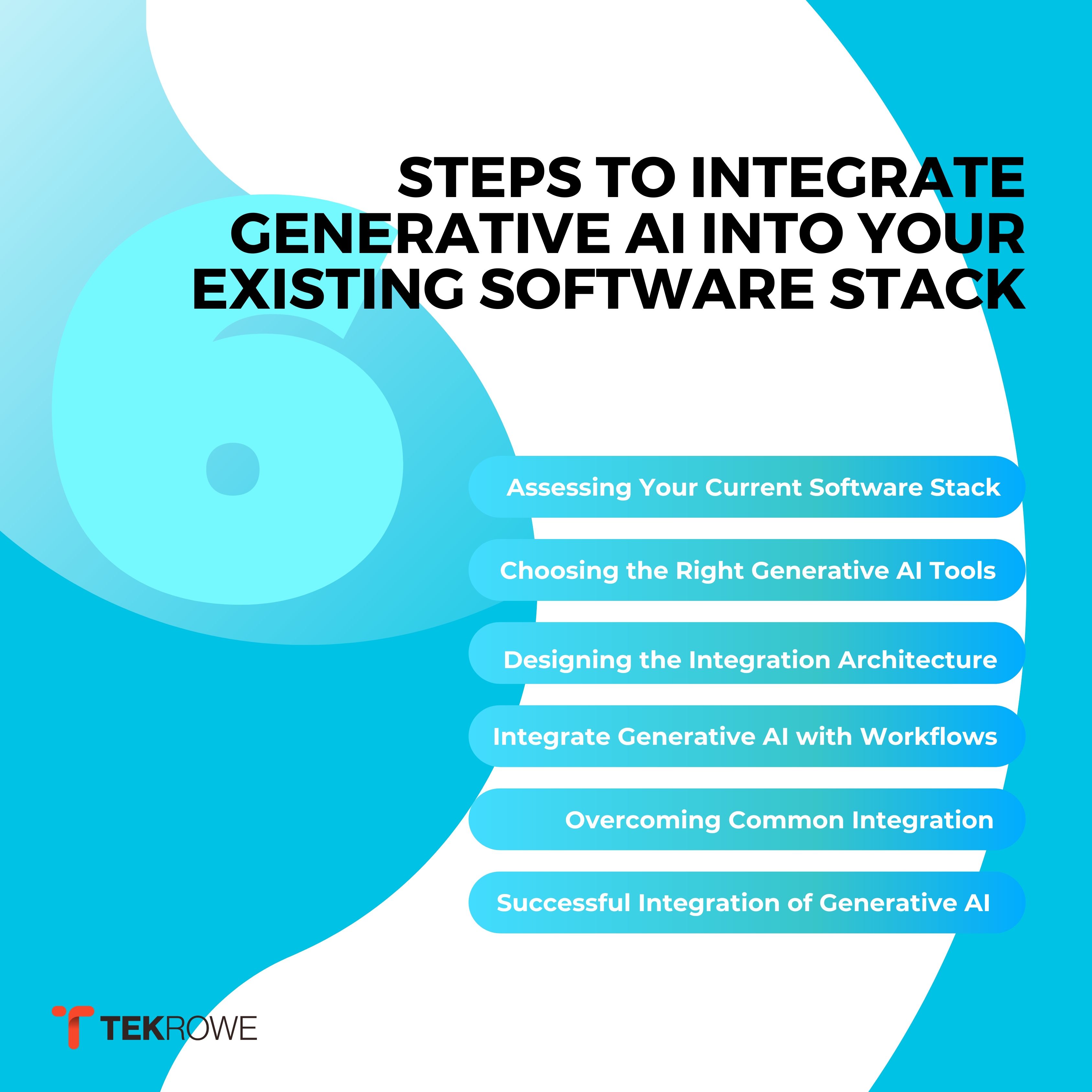
1. Assessing Your Current Software Stack
The first step is to evaluate your existing software infrastructure to understand its components and capabilities. Start by conducting a thorough inventory of all tools, frameworks, and platforms currently in use. Identify whether your system already incorporates any form of artificial intelligence or machine learning technology, as this can provide a starting point for further integration.
Once you understand the tools you are working with, evaluate their compatibility with generative AI. This includes checking programming languages, system architecture, APIs, and data formats to ensure they align with the requirements of AI models. Assess whether your current technology stack is flexible enough to incorporate generative AI without extensive modifications.
After evaluating compatibility, determine where generative AI can make the most impact. Look for specific integration points within your system, such as automating repetitive processes, enhancing personalization, or generating creative content. Identifying these opportunities helps prioritize the areas where AI can add the greatest value.
2. Choosing the Right Generative AI Tools and Frameworks
Once you have assessed your existing infrastructure, the next step is selecting the most suitable tools and frameworks for generative AI integration. Start by understanding the various generative AI models available and their capabilities. Generative Pretrained Transformers (GPT) are ideal for text-based tasks, while Generative Adversarial Networks (GANs) excel at image generation and creative applications. Variational Autoencoders (VAEs) are another option, commonly used for data reconstruction tasks.
Deciding between open-source and proprietary tools is another critical consideration. Open-source frameworks like TensorFlow, PyTorch, or Hugging Face offer flexibility and cost savings, while proprietary solutions such as OpenAI’s API provide enhanced support, prebuilt models, and advanced features. Carefully evaluate the learning curve associated with each option and ensure your team has the skills needed to work with the chosen technology.
Additionally, consider how well these tools can integrate with your existing system. Look for solutions that offer robust APIs and thorough documentation to facilitate seamless communication between your software and the AI models. Scalability is also essential, as the chosen tools must accommodate increased demands as your business and AI usage grow.
3. Designing the Integration Architecture
With the right tools and frameworks selected, focus on designing the integration architecture. Start by defining the various layers of the system, including data input, AI model processing, and output generation. Include additional layers for data preprocessing, model training, and inference. A modular design is ideal because it enables easy updates, scalability, and maintenance.
Develop a robust data management strategy to ensure your generative AI models have access to clean, high-quality data. This involves processes like data collection, cleaning, validation, and storage. Implement automated data pipelines to streamline the flow of information between your system and the AI components.
Use APIs and microservices to connect your generative AI tools to the existing software stack. Microservices allow different components to communicate with the AI models without disrupting the broader system architecture. At this stage, also address security concerns by implementing encryption, access controls, and compliance measures for handling sensitive data, particularly if regulations like GDPR or HIPAA apply.
To maintain system performance, incorporate monitoring and logging mechanisms that track the AI model’s output, speed, and accuracy. This ensures any issues can be detected early, enabling continuous optimization of the system.
4. Integrating Generative AI with Existing Workflows
Once the architecture is in place, focus on seamlessly integrating generative AI into your existing workflows. Begin by identifying the key processes or workflows that will benefit most from AI enhancements. For example, customer service workflows can use AI to generate automated responses, while marketing workflows might leverage AI to create personalized content.
Start with a pilot program to test the AI integration in a controlled environment. Pilots allow you to monitor performance, gather feedback, and identify any areas that require adjustments before scaling the solution. Based on the pilot results, refine the AI’s role in specific workflows to ensure maximum efficiency.
User adoption is critical for successful integration, so train your team on how to use generative AI tools effectively. Workshops, tutorials, and hands-on sessions can help employees understand the value AI brings to their workflows. Demonstrating tangible benefits, such as time savings or improved output, can encourage greater acceptance and adoption.
Deploy the AI solution iteratively, focusing on critical workflows first and expanding gradually. This phased approach allows for smoother integration and minimizes disruption. Utilize automation tools to orchestrate various components of the system, ensuring the generative AI operates seamlessly alongside other processes.
5. Overcoming Common Integration Challenges
Integrating generative AI into an existing system often comes with challenges, so being prepared to address them is essential. One of the most common issues is data quality. AI models rely on high-quality data to deliver accurate outputs. Implement processes to validate and clean data before feeding it into the AI system to maintain accuracy and reliability.
Scalability can also present challenges as AI usage grows. To address this, ensure your infrastructure is optimized for increased workloads, possibly leveraging cloud-based solutions or distributed computing for flexibility. Integration complexity is another issue, as connecting generative AI with existing software can require significant effort. Simplify this process by breaking it into smaller tasks and using integration platforms or middleware where necessary.
Resistance from end-users can slow down adoption. To overcome this, involve users early in the process and address their concerns with targeted training and support. Demonstrate the practical benefits AI brings to their workflows to encourage engagement. Finally, plan for ongoing maintenance and upgrades to ensure the AI models remain efficient as technology evolves and new requirements emerge.
6. Case Studies: Successful Integration of Generative AI
To understand the real-world impact of generative AI, consider examples of successful integrations across industries.
In the e-commerce sector, businesses have used generative AI to analyze customer behavior and preferences, generating personalized product recommendations. This led to higher customer satisfaction and significant increases in sales.
A digital marketing agency leveraged generative AI to automate the creation of social media content. The AI produced creative, high-quality text and visuals, reducing content development time and enabling the team to focus on strategic initiatives.
In healthcare, generative AI has been integrated into diagnostic tools to analyze patient data and generate tailored treatment plans. The use of AI improved diagnostic accuracy and patient outcomes while optimizing resource utilization.
Best Practices for Long-Term Success
To ensure long-term success with your generative AI tech stack, consider the following best practices:
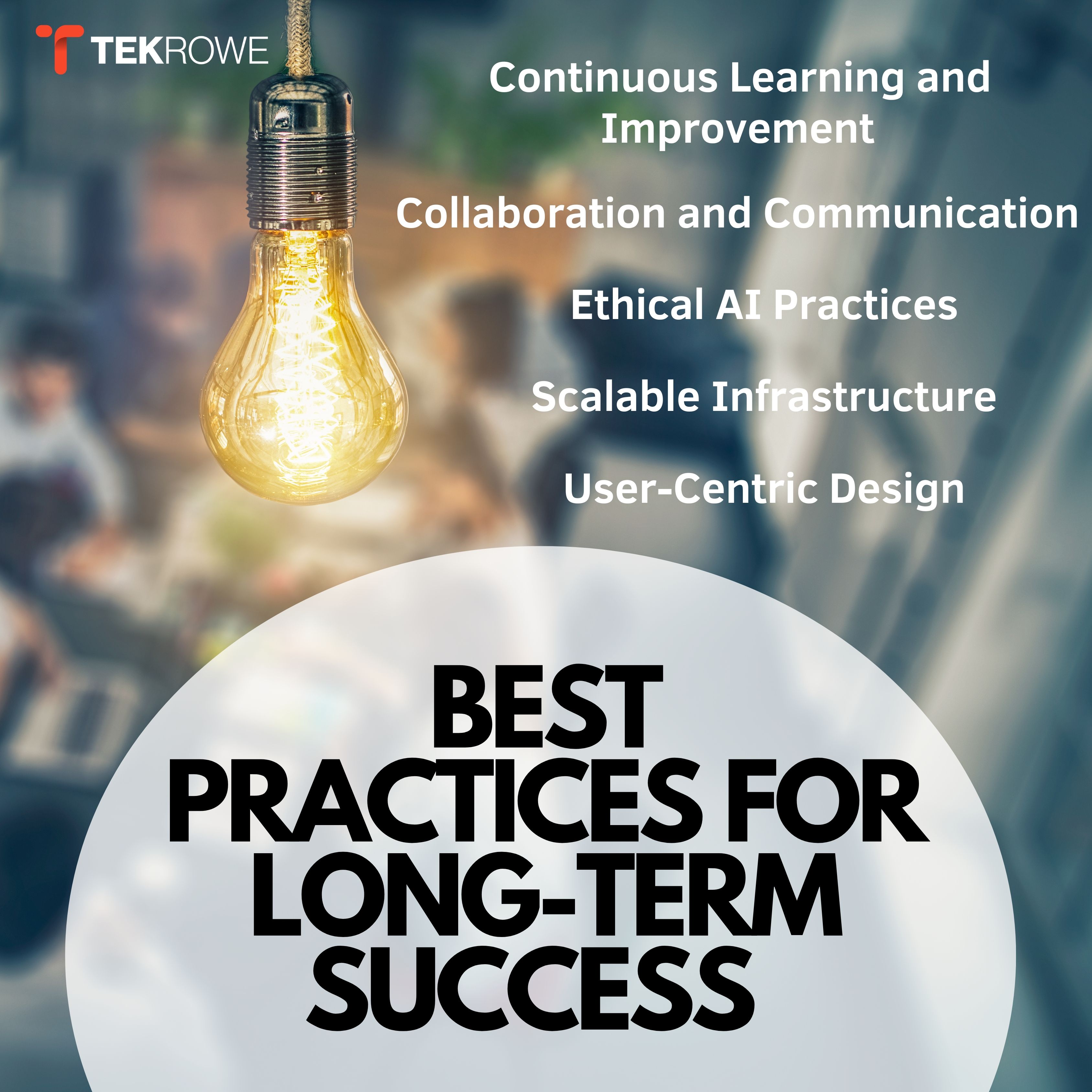
Continuous Learning and Improvement:
- Encourage continuous learning within your team to stay updated on the latest AI trends and techniques. This will help you keep your AI models relevant and effective.
- Regularly review and refine the AI models based on performance data and user feedback.
Collaboration and Communication:
- Foster collaboration between AI specialists, developers, and business stakeholders. Effective communication is key to ensuring that the AI solutions align with business goals and technical requirements.
- Use collaborative tools and platforms to facilitate communication and project management.
Ethical AI Practices:
- Implement ethical AI practices by ensuring transparency, fairness, and accountability in your AI models. This includes avoiding bias in AI-generated content and ensuring that AI decisions are explainable.
- Regularly audit your AI models to ensure they adhere to ethical standards and industry regulations.
Scalable Infrastructure:
- Invest in scalable infrastructure that can grow with your AI needs. This includes cloud-based solutions, containerization, and serverless computing, which can provide the flexibility and scalability required for AI workloads.
- Optimize resource allocation to balance cost and performance effectively.
User-Centric Design:
- Design AI solutions with the end-user in mind. Ensure that the AI models are intuitive and easy to use, and that they add tangible value to the user's experience.
- Collect user feedback regularly to refine the AI solutions and improve user satisfaction.
Need Help with Your Business
Contact Us NowFuture Trends in Generative AI Integration
As the integration of generative AI advances, several future trends are emerging within the gen AI tech stack and broader artificial intelligence technology stack. One prominent trend is the expansion of multimodal AI, where AI models combine data types like text, images, and audio to generate more complex outputs. This enhances the capabilities of the machine learning tech stack and allows for richer, more interactive applications.
Another trend is the shift towards AI-driven automation. As AI models within the machine learning technology stack become more sophisticated, they are increasingly being used to automate complex tasks across various industries. This automation reduces the need for manual intervention, allowing for more efficient operations and enabling human workers to focus on strategic activities.
Edge computing is also set to play a critical role in the future of AI integration. By deploying AI models closer to the data source, organizations can reduce latency and improve the real-time processing capabilities of their ML tech stack. This is particularly important in fields like IoT and autonomous systems, where fast decision-making is crucial.
Finally, there is a growing focus on ethical AI practices within the gen AI tech stack. As AI models generate increasingly influential content, ensuring transparency, fairness, and accountability in these systems is becoming a priority. This trend will likely lead to the development of new governance frameworks within the artificial intelligence technology stack, ensuring that AI is used responsibly and ethically.
Conclusion
Integrating a generative AI tech stack into your existing software infrastructure offers immense potential to enhance your systems and processes. By carefully assessing your current software stack, choosing the right tools, designing a robust architecture, and following best practices, you can successfully integrate generative AI and unlock new opportunities for innovation and efficiency. As the field of AI continues to evolve, staying informed about the latest trends and advancements will ensure that your AI integration remains effective and future-proof.
FAQs
What is a generative AI tech stack?
The generative AI tech stack is a collection of tools, frameworks, and technologies used to develop, train, and deploy AI models capable of generating new content, such as text, images, or code. It typically includes infrastructure like cloud services, model development tools like TensorFlow, data management systems, and deployment platforms.
How does a generative AI tech stack differ from a traditional machine learning tech stack?
While both stacks involve data processing, model training, and deployment, the gen AI tech stack is specifically designed for models that create new data or content, such as GANs and VAEs. Traditional machine learning tech stacks focus more on analyzing and predicting based on existing data rather than generating new outputs.
What are the key challenges in integrating a generative AI tech stack?
Integrating a generative AI tech stack involves challenges such as ensuring data quality, managing the high computational demands of AI models, and integrating AI-generated content seamlessly into existing systems. Additionally, maintaining ethical AI practices and handling scalability are critical considerations.

